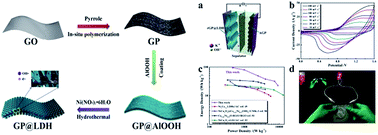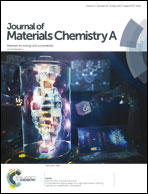Remarkable supercapacitor performance of petal-like LDHs vertically grown on graphene/polypyrrole nanoflakes†
Abstract
A 3D hybrid nanostructure, in which petal-like ultrathin nickel–aluminum layered double hydroxides (LDHs) were vertically grown on a conductive graphene/polypyrrole (GP) substrate, was designed and fabricated by a facile hydrothermal method. SEM and TEM observations confirmed the successful synthesis of this specially designed nanostructure, in which the conductive substrate ensures very fast electron transfer during the charge–discharge process, whereas the 3D hierarchical structure facilitates rapid ion transfer. The ultrathin LDH nanoflakes (3–5 nm) expose their abundant active sites to the electrolyte, thus generating huge pseudocapacitance. Combining the abovementioned features, this specially designed 3D nanostructured hybrid possesses an exceptional specific capacitance (2395 F g−1 at 1 A g−1), excellent rate performance (retaining 71.8% of capacitance at the current density of 20 A g−1), and remarkable cycling stability (99.6% retention after 10 000 cycles). Moreover, the assembled asymmetric supercapacitor obtained using GP@LDH as a positive electrode and GP-derived carbon as a negative electrode exhibits an ultrahigh energy density of 94.4 W h kg−1 at the power density of 463.1 W kg−1, making GP@LDH very attractive as an electrode material for high performance and low-cost supercapacitors.



 Please wait while we load your content...
Please wait while we load your content...